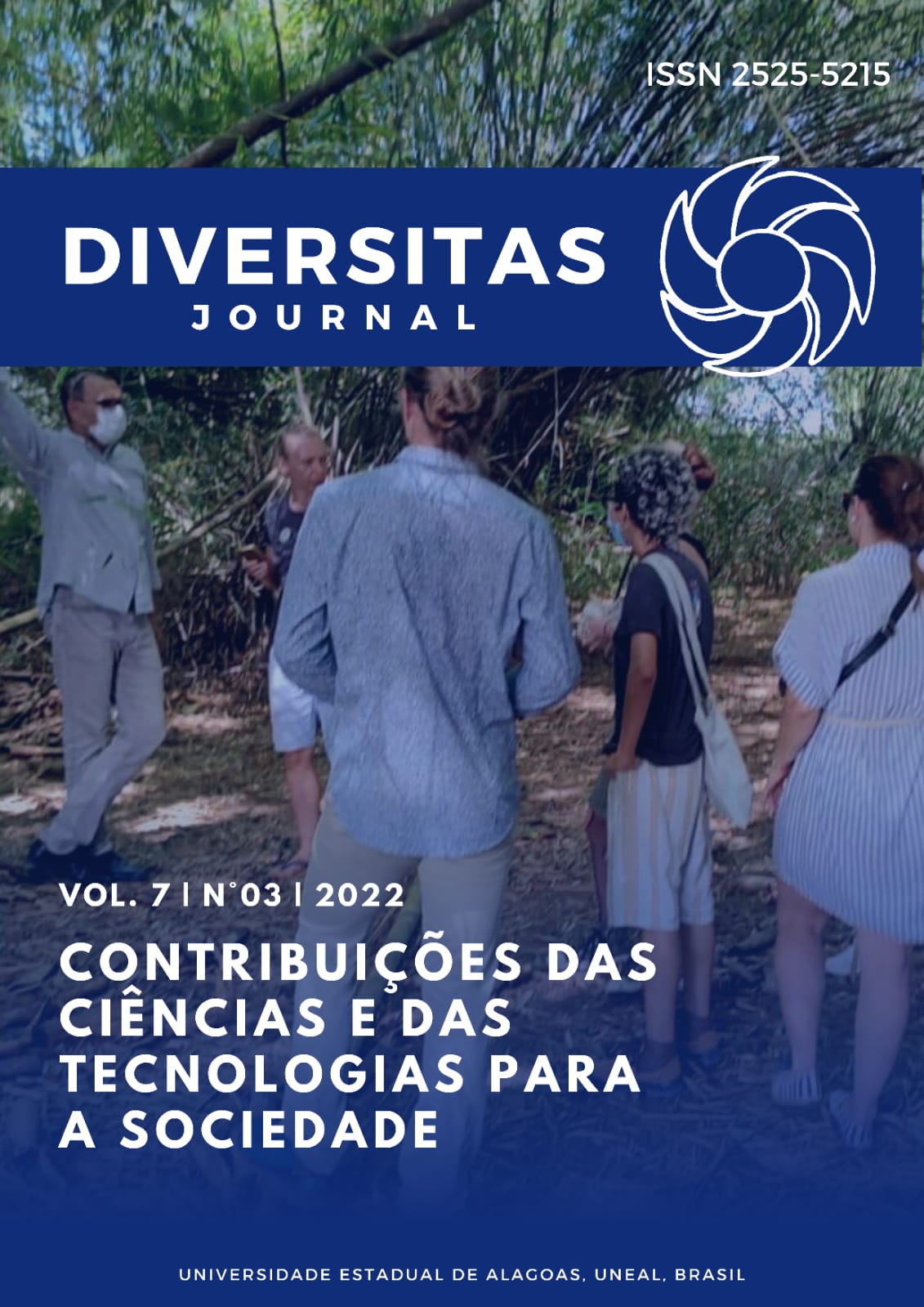Ocorrência de COVID-19 nos países com mais casos no mundo (2019-2021)
DOI:
https://doi.org/10.48017/dj.v7i3.2186Keywords:
Pandemic, epidemiological reports, SARS-Cov-2Abstract
The World Health Organization classified the novel coronavirus (Covid-19), a severe acute respiratory illness, as a pandemic in March 2020. The etiological agent is the SARS-CoV-2 virus, which emerged in Wuhan, China, in December 2019. Symptoms of infection can range from cough, fever, and nasal congestion to severe pneumonia. In view of the spread that the new coronavirus has taken, this study aimed to report the evolution of COVID-19 cases in the countries where there were more records, as well as recovered cases and deaths, during the period from December 2019 to December 2021. This is a descriptive and retrospective study carried out using epidemiological reports made available by the Brazilian Ministry of Health. The results obtained showed that the United States, India and Brazil had the highest cumulative number of cases, deaths and recovered cases. Understanding that the global epidemiological scenario of Covid-19 changes daily, it is concluded that it is necessary, above all, to warn that redoubling ethical rigor and not relaxing are essential, especially in the face of a major pandemic affected by an unknown disease, which naturally causes fear and insecurity.
References
Bhadra, A., Mukherjee, A., & Sarkar, K. (2021). Impact of population density on Covid-19 in-fected and mortality rate in India. Modeling Earth Systems and Environment, 7 (1), 623–629. https://doi.org/10.1007/s40808-020-00984-7
Brasil. Ministério da Saúde. (2012). Resolução nº 466, de 12 de dezembro de 2012. Conselho Nacional de Saúde. Publicada no DOU nº 12, 13 de junho de 2013. Disponível em: https://conselho.saude.gov.br/resolucoes/2012/Reso466.pdf>. Acesso em dezembro de 2021.
Brasil. Ministério da Saúde. (2020). Doença pelo novo Coronavírus — COVID-19: Monitora-mento até a Semana Epidemiológica 51 de 2020. Boletim Epidemiológico N° 42. Secre-taria de Vigilância em Saúde. Disponível em: < https://www.gov.br/saude/pt-br/centrais-de-conteudo/publicacoes/boletins/boletins-epidemiologicos-covid-19/2020/boletim_covid_42_24dez20.pdf> Acesso em: 16 de dezembro de 2021.
Brasil. Ministério da Saúde. (2021). Doença pelo novo Coronavírus — COVID-19: Monitora-mento até a Semana Epidemiológica 48 de 2021. Boletim Epidemiológico N° 92. Secre-taria de Vigilância em Saúde. Disponível em: < https://www.gov.br/saude/pt-br/centrais-de-conteudo/publicacoes/boletins/boletins-epidemiologicos-covid-19/2021/boletim_epidemiologico_covid_92_10dez21.pdf/ Bole-tim_epidemiologico_COVID_92_15dez21.pdf> Acesso em: 16 de dezembro de 2021.
Cavalcante, J. R., Cardoso-dos-Santos, A. C., Bremm, J. M., Lobo, A. P., Macário, E. M., Olivei-ra, W. K., & França, G. V. A. (2020). COVID-19 no Brasil: evolução da epidemia até a semana epidemiológica 20 de 2020. Epidemiologia e Serviços de Saúde, Brasília, 29(4), e2020376. https://doi.org/10.5123/S1679-49742020000400010.
Demenech, L. M., Dumith, S. C., Vieira, M. E. C., & Neiva-Silva, L. (2020). Desigualdade eco-nômica e risco de infecção e morte por COVID-19 no Brasil. Revista Brasileira de Epi-demiologia, 23. https://doi.org/10.1590/1980-549720200095.
Flynn, D., Moloney, E., Bhattari, N., Scott, J., Breckons, M., Avery, L., & Moy, N. (2020). CO-VID-19 pandemia no Reino Unido. Política e Tecnologia de Saúde. Elsevier, 9(4), 673-691. https://doi.org/10.1016/j.hlpt.2020.08.003.
Harapan, H., Itoh, N., Yufika, A., Winardi, W., Keam, S, Te, H., Megawati, D., Hayati, Z., Wag-ner, A., & Mudatsir, M. (2020). Coronavirus disease 2019 (COVID-19): A literature re-view. Journal of infection and public health, 13(5), p. 667-673. https://doi.org/10.1016/j.jiph.2020.03.019.
Iser, B. P. M., Silva, I., Raymundo, V. T., Poleto, M. B., Schuelter-Trevisol, F., & Bobinski, F. (2020). Definição de caso suspeito da COVID-19: uma revisão narrativa dos sinais e sin-tomas mais frequentes entre os casos confirmados. Epidemiologia e Serviços de Saúde, 29. https://doi.org/10.5123/S1679-49742020000300018.
Miranda, F. (2021). Pandemias e História na Era da COVID-19. Medievalista, 29, 411-418. https://doi.org/10.4000/medievalista.4008.
Oliveira, E. H. A. (2020). Coronavírus: prospecção científica e tecnológica dos fármacos em estudo para tratamento da Covid-19. Cadernos de Prospecção, 13 (2) Edição Especial COVID-19, 412. https://periodicos.ufba.br/index.php/nit/article/view/36153.
Oliveira, J. P. S., Costa, A. C. B., Lopes, E. K. S., Silva, L. J., Gomes, K. B., Oliveira, S. S., & Bar-ros, R. P. (2020). Entendimento da COVID-19 sobre aspectos relacionados ao distanci-amento social. Research, Society and Development, 9(10), e5739108983-e5739108983. https://doi.org/10.33448/rsd-v9i10.8983.
Pramanik, M., Udmale, P., Bisht, P., Chowdhury, K., Szabo, K., & Pal, I. (2020). Climatic fac-tors influence the spread of COVID-19 in Russia. International journal of environmen-tal health research, 1-15, jul. 2020. https://doi.org/10.1080/09603123.2020.1793921
Senhoras, E. M. (2021). O campo de poder das vacinas na pandemia da Covid-19. Boletim de conjuntura (BOCA), v. 6, n. 18, p. 110-121. https://doi.org/10.5281/zenodo.5009525.
Singhal, T. (2020). A Review of Coronavirus Disease-2019 (COVID-19). The Indian Journal of Pediatrics, 87(4), 281–286. https://doi.org/10.1007/s12098-020-03263-6.
Souza, L. E. P. F., & Buss, P. M. (2021). Desafios globais para o acesso equitativo à vacinação contra a COVID-19. Cadernos de Saúde Pública, 37(9), e00056521. https://doi.org/10.1590/0102-311X00056521.
Rothan, H. A., & Byrareddy, S. N. (2020). The epidemiology and pathogenesis of coronavirus disease (COVID-19) outbreak. Journal of Autoimmunity, 109, 102433. https://doi.org/10.1016/j.jaut.2020.102433.
World Health Organization - WHO. (2020a). Director-General’s opening remarks at the media briefing on COVID-19 – 11. Disponível em: https://www.who.int/dg/speeches/detail/whodirector-general-s-opening-remarks-at-the-media-briefing-on-covid-19---11-march-2020. Acesso em 5 de agosto de 2021.
World Health Organization - WHO. (2020b). Coronavirus disease 2019 (COVID-19) situation reports-69. Disponível em: https://www.who.int/docs/defaultsource/coronaviruse/situation-reports/20200329- sitrep-69-covid-19.pdf?sfvrsn=8d6620fa_8. Acesso em: em 5 de agosto de 2021.
Additional Files
Published
How to Cite
Issue
Section
License
Copyright (c) 2022 Samara dos Santos Oliveira, Karoline Barbosa Gomes, Ellen Karollyne Santos Lopes, Allana Caroline Bonfim Costa, Liosmar José da Silva, Claudimary Bispo dos Santos

This work is licensed under a Creative Commons Attribution 4.0 International License.
The Diversitas Journal expresses that the articles are the sole responsibility of the Authors, who are familiar with Brazilian and international legislation.
Articles are peer-reviewed and care should be taken to warn of the possible incidence of plagiarism. However, plagiarism is an indisputable action by the authors.
The violation of copyright is a crime, provided for in article 184 of the Brazilian Penal Code: “Art. 184 Violating copyright and related rights: Penalty - detention, from 3 (three) months to 1 (one) year, or fine. § 1 If the violation consists of total or partial reproduction, for the purpose of direct or indirect profit, by any means or process, of intellectual work, interpretation, performance or phonogram, without the express authorization of the author, the performer, the producer , as the case may be, or whoever represents them: Penalty - imprisonment, from 2 (two) to 4 (four) years, and a fine. ”


















